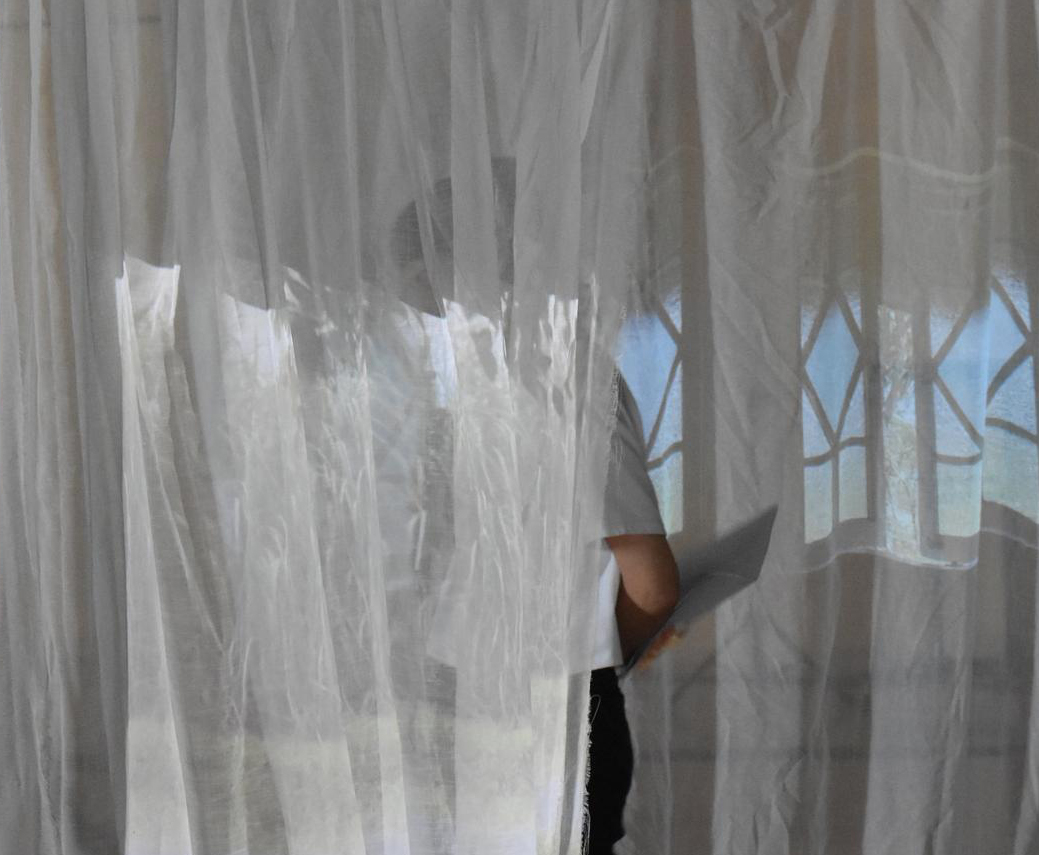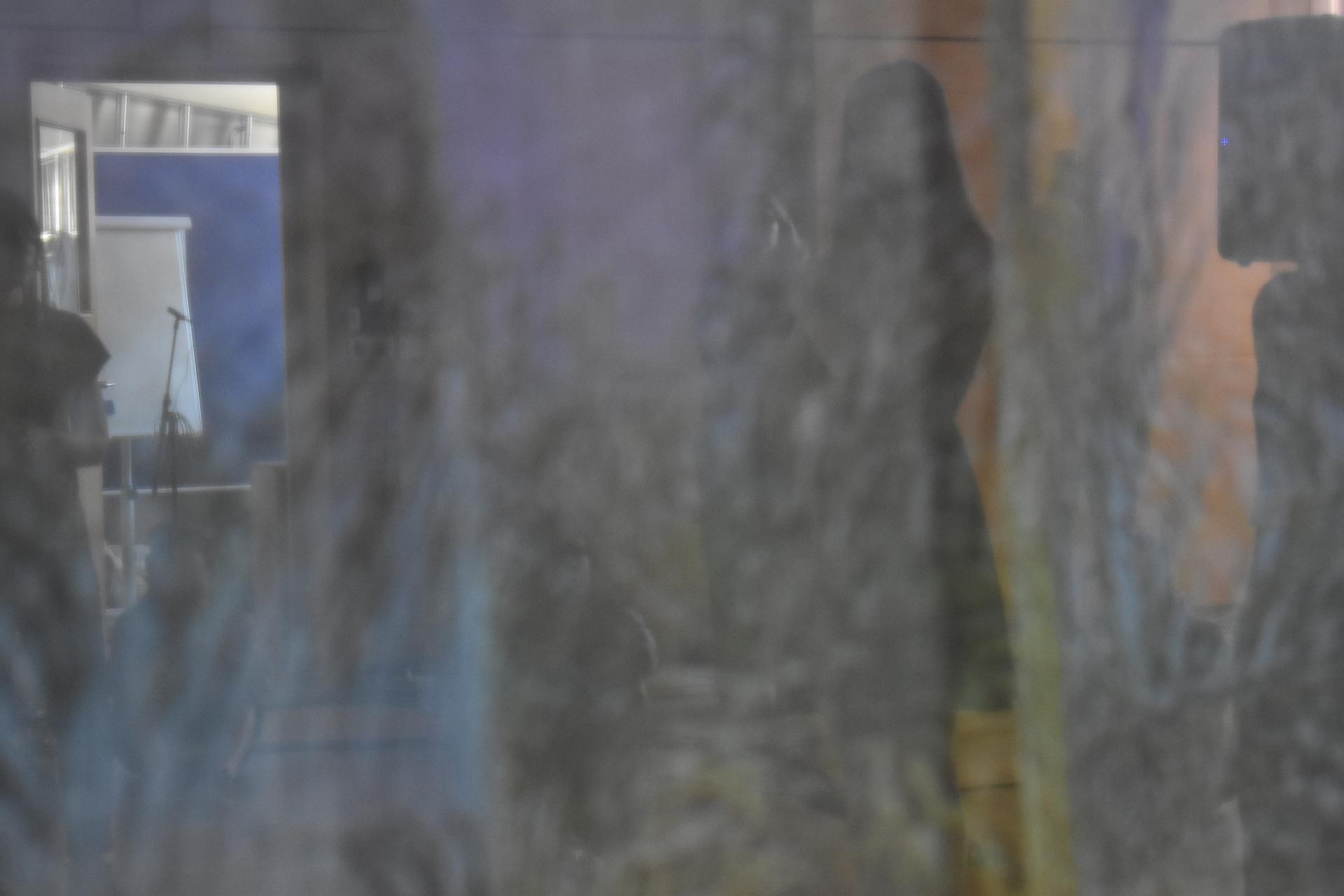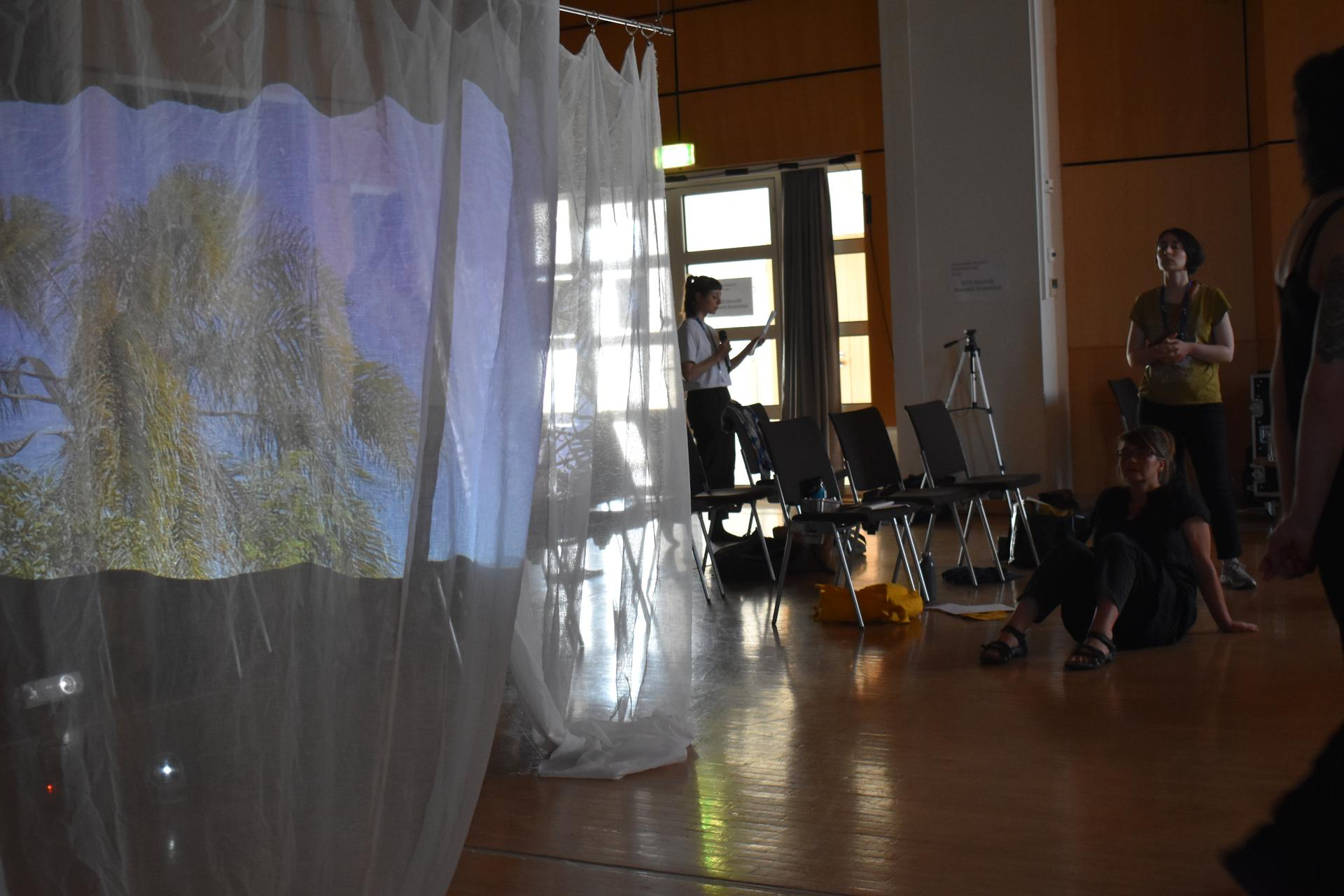This exposition is published in the Proceedings of the 1st symposium Forum Artistic Research: listen for beginnings.
This is an audio paper version (Fig. 2) of Braced Under the Heating Sun adapted from the lecture-performance (Fig. 1) as part of the symposium Listen for Beginnings at GMPU Klagenfurt on Friday 28th June 2024. In this audio paper both the voice and field recordings melt and blur into the textures of one another. Please use headphones for immersive listening.
The original artwork is a multi-channel sound installation that includes two projections on semi-opaque curtains and was first exhibited at KIOSK, Ghent as part of Encounter in Resonance in 2021. In this audio paper I discuss the installation and my continued practice-led research on embodied listening.
Figs. 3–4 show a documentation of the lecture-performance, and below follows the transcript.
[Transcript]
I would like to acknowledge and pay respect to the Mamu peoples, the traditional custodians of the land on which my childhood home was built and where the recording for this project takes place. I recognise that they have never ceded their sovereignty.
Braced under the heating sun
This installation, Braced Under the Heating Sun is centred around listening to and documenting my childhood home and its aural particularities through processes of embodied listening. The project is based on my recordings and experiences there between February and March 2020. These dates are bookended by the waning Australian black summer bush fires and the burgeoning COVID-19 pandemic. The bush fires were not in this zone but the weather was still incredibly hot and dry for what is usually a tropical cyclone season.
The house is made from wood and so bends with the weather. The wooden structure amplifies the sounds of our habitation. The house is located on the edge of a small town next to a sugar cane farm in North Queensland on the tropic of Capricorn. Although in a tropical climate, the house has no fly screens and air-conditioning in only one room. The windows are always open to let a breeze through. Most evenings you can find green tree frogs, geckos and insects amongst other animals in or around the house.
In this way nature (a wild exterior) pushes against and blurs into the home (an organised interior). It is never silent there, the sounds are a mix of all forces; human/animal, natural/industrial.
For me, this site resonates with the world around despite its rural location. In this house, as Elizabeth Grosz says: “rhythms and cycles of the living and the immediate needs of every living being are highlighted and played out. It is where intensities proliferate themselves, where forces are expressed for their own sake, where sensation lives and experiments, where the future is affectively and perceptually anticipated” (Grosz 2008, 78–79). Through this lens, I reflect on the sonorous qualities of the house as a resonating site that picks up, amplifies and filters certain cultural and ecological rhythms. For this piece, these sonorous qualities were then captured and transformed, guided by my process of embodied listening.
I gathered hours and hours of material, building an archive of this site. But how does one deal with this amount of material?
As I was relistening (on- and offsite), I made notes on moments where I started to see certain cyclical sonic events arise. These events were made visible through the lengthy recordings, and an idea started to form where I would organise the work into five chapters around them.
The five resulting chapters, of which you hear currently a shortened version of, include:
-
The creaking of the wooden structure as it adapts to the heat. As the tin roof heats from around 26 degrees to 36 degrees in the morning hours, the metal expands, and the entire house moves in a very precise timely way to these environmental changes. In this track, I feel the unbearableness of it continuing. The not-fading-out. The not-concluding. The non-conclusiveness of the house always sounding in response to the incessant summer heat.
-
The texture of voices announcing themselves and resonating in this place. In this track we hear family nonsense, dramatic storytelling, and bad jokes. Sharing. Trying to out-wind each other. Wind blowing through the trees and the entire garden. That one bug that buzzes close to the mic. Thongs on grass, on the lino, on the cement. Lazy day-geckos. Chatty parrots. Everything voices itself in its own capacity. Everything and everyone speaks to each other. It is the general soundscape that happens when my family is together. Constant blabber.
-
The polyphonic song of cicadas and other insects from dusk until dawn. A 14-hour recording that was cut down as the insect songs change. When there is human activity, particularly voices, other sounds seem less important. When listening back, I’m not sure if I’m inside or outside. But the human activity grounds me. I feel quiet and still. Sleepy. I feel as if there is another watching or listening body sometimes. The world is alive and breathing. It is unstoppable. When you are there, in the lived present, it’s just background noise.
-
The sound of the lawnmower as it is pushed through the grass around the house. It is a soundscape of the drawn-out-midday-time of a small town. The buffalo grass has had time to dry. The sun is up and blazing hot. No one, no thing, moves unless out of necessity. It rained once two weeks ago and now the grass seeds have popped and if it gets any higher, it’ll be harder to mow. The mower catches brutally on the fig tree roots disturbing this heavy silence.
-
A short storm that blows in from the sea and only cools things down for a minute before the constant humid heat returns. We hear a noisy sleeper. There is a break from the heat. Fresh water pouring down, Smelling petrichor from the bitumen, petrichor from the garden.
The total duration of the installation is around 50 minutes. It also includes two unsynchronised projections.
Embodied Listening
Now, to return to the practice of embodied listening through a theoretical framework and methodology: Embodied listening is a phenomenological approach. It is a process. As a methodology, it places my own body as the first testing ground in my practice, emphasising an active attention to all the senses. As the project opens up, the work is shared with other bodies. There is a transmission of experience, which may then lead to other forms of embodied listening.
As David Abram (1996, 47) said “far from restricting my access to things and to the world, the body is my very means of entering into relation with all things…”.
Embodied listening could also be described, in Martine Huvenne’s words, where “[w]ith the body at the centre of its experience, pre-reflective kinaesthetic experiences are characterised by bodily intentionality, a passive synthesis that brings together sensory experiences into a single world. Bodily intentionality is an open sensitivity which has no clear subject–object structure. Merleau Ponty (2012, 244) describes this very clearly by saying ‘In my body, visual and auditory experiences [and I would add all the other senses too] are pregnant with each other, and their expressive value grounds the pre-predicative unity of the perceived world, and through this, its verbal expression and intellectual signification’” (Huvenne 2022, 286).
To create this work I undertook an extensive and extended embodied listening field recording process. Working with multiple microphones; an ambisonic mic, two omni directional microphones and a contact mic. Keeping in mind this question: how can lived experience be mediated? For example: mics record differently than how we listen/perceive. Technology is far from a neutral interface.
Before recording I try to be aware of my own kind of listening, because I think of listening as in flux. I try to consider what influences me, the process of my listening, and how is attention drawn? What highlights certain moments and not others?
Starting in my own body: I note sensations that arise in relation to the environment – perhaps these are not present in the recordings but they influence my listening all the same…
Or we might call it “the listener’s listening”, coined by Lawrence English, in which he describes his field recording practice “as intensively agentive in the sense that it is not ongoing or unattended, but rather temporal, reflecting an artist-researcher’s intense engagement with sound in place across time…” (English 2017, 54) and where “[a] listener must be ultimately attentive to the sound events that unfold in time and place, and through doing so can create a listening that is unique” (ibid.).
When documenting with sound:
-
I place the microphones attentively.
-
When recording, I record with intention! This evolves out of paying attention and developing a certain sensitive awareness of everyday experiences, place and materials, and also testing out different sites – following my ears.
-
Through re-listening processes, I create a library with keywords.
-
Final outcomes should be guided by what is recorded/experienced on site.
-
Being open to multiple formats (although certain recording formats can dictate certain outcomes… and an embodied field recording process doesn’t always mean a sound installation).
-
Lastly, play should always be considered as an important testing ground for exploring different aesthetics, processes, experimentations…
So, to conclude, through the process of embodied listening to this particular site, the following topics arose; cohabitation (relationships between living things), the interconnectedness of rhythms and cycles of the everyday and how the porosity of architecture offered moments where boundaries broke and the lives of different beings crossed, where there was a constant push and pull between the ‘other’ and the ‘human’.
Thank you for listening.
[END]
References
- Abram, David. 1996. The Spell of the Sensuous; Perception and language in a more-than-human world. Vintage Books.
- English, Lawrence P. 2017. The Listener’s Listening. PhD, Queensland University of Technology. https://eprints.qut.edu.au/110620/ (accessed 20 July 2025).
- Grosz, Elizabeth. 2008. Chaos, Territory, Art: Deleuze and the Framing of the Earth. Columbia University Press.
- Huvenne, Martine. 2022. The Audiovisual Chord. Palgrave Macmillan.
- KIOSK. 2021. Encounter in Resonance. Online: https://kiosk.art/encounter-in-resonance-exhibition (accessed 20 July 2025).
- Merleau-Ponty, Maurice. 2012. Phenomenology of Perception. Trans. Donald. A. Landes. Routledge.





